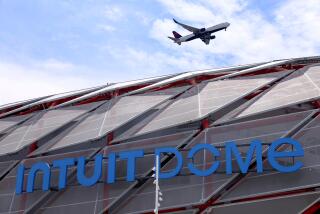Legislators’ ‘hot dog’ definition would aid street vendors
- Share via
SACRAMENTO — Americans have been eating hot dogs since at least 1870, when a Coney Island restaurateur started selling sausages on long buns.
In California’s capital, hot-dog carts keep the tradition going with cheap, quick, lunches for state workers and tourists.
But cart owners around the state are threatened with closure by health inspectors, unless lawmakers come to their rescue.
That’s why the Assembly Health Committee had to come up with a legal definition for “hot dog.” The proposed change to state health laws spells it out: “‘Hot dog’ means a whole, cured, cooked sausage that is skinless or stuffed in a casing that may be known as a frankfurter, frank, furter, wiener, red hot, Vienna, bologna, garlic bologna or knockwurst and that may be served in a bun or roll.”
There’s a good reason for the legalese, said committee Chairman Richard Pan (D-Sacramento). “When Californians buy hot dogs, they want to know what they are getting, sometimes with mustard,” he said.
The definition is needed so health departments can hold hot-dog vendors, who boil already cooked wieners, to a less-stringent sanitation standard than food stands that cook raw foods, such as bratwurst, said Justin Malan of the California Assn. of Environmental Health Administrators.
The bill, AB 1252, passed the Assembly unanimously and moved to the Senate. But the bill fails to include other names for the all-American treat. According to thesaurus.com, hot dogs also are known as weenies, foot-longs, Coney Islands, links, wiener wursts, pigs in blankets. The bill also doesn’t list a Los Angeles favorite: Dodger Dogs.
Moving the goal posts
California law mandates that electric utilities generate at least one-third of their power from renewable sources by 2020.
With 7 1/2 years left before the deadline, the state’s three big investor-owned utilities now get a collective 22% from wind, solar and other non-fossil fuels.
Now, Assemblyman V. Manuel Pérez (D-Coachella) wants to move the goal posts. He’s introduced a bill, AB 177, that sets a 51% target by 2030.
Environmentalists are thrilled. “California needs to keep pushing forward,” said Bernadette Del Chiaro, a renewable-power advocate with Environment California.
Manufacturers, who say they have been working to be more energy-efficient while paying some of the country’s highest electric rates, aren’t enthusiastic. “Adopting a policy to keep energy rates rising is the exact opposite of what we should be doing,” said Dorothy Rothrock, vice president of the California Manufacturers & Technology Assn.
Lower-cost cellphones
Regulators are considering a program to provide subsidized cellphones and service to low-income Californians. Ratepayer advocates contend that a similar federal program is too limited to be useful. But an opponent, the National Tax Limitation Committee, says the proposal is a costly duplication of the federal one. The Public Utilities Commission will hold a public hearing at 4 p.m. Tuesday at the Caltrans building at 100 S. Main St. in downtown Los Angeles.
More to Read
Inside the business of entertainment
The Wide Shot brings you news, analysis and insights on everything from streaming wars to production — and what it all means for the future.
You may occasionally receive promotional content from the Los Angeles Times.











